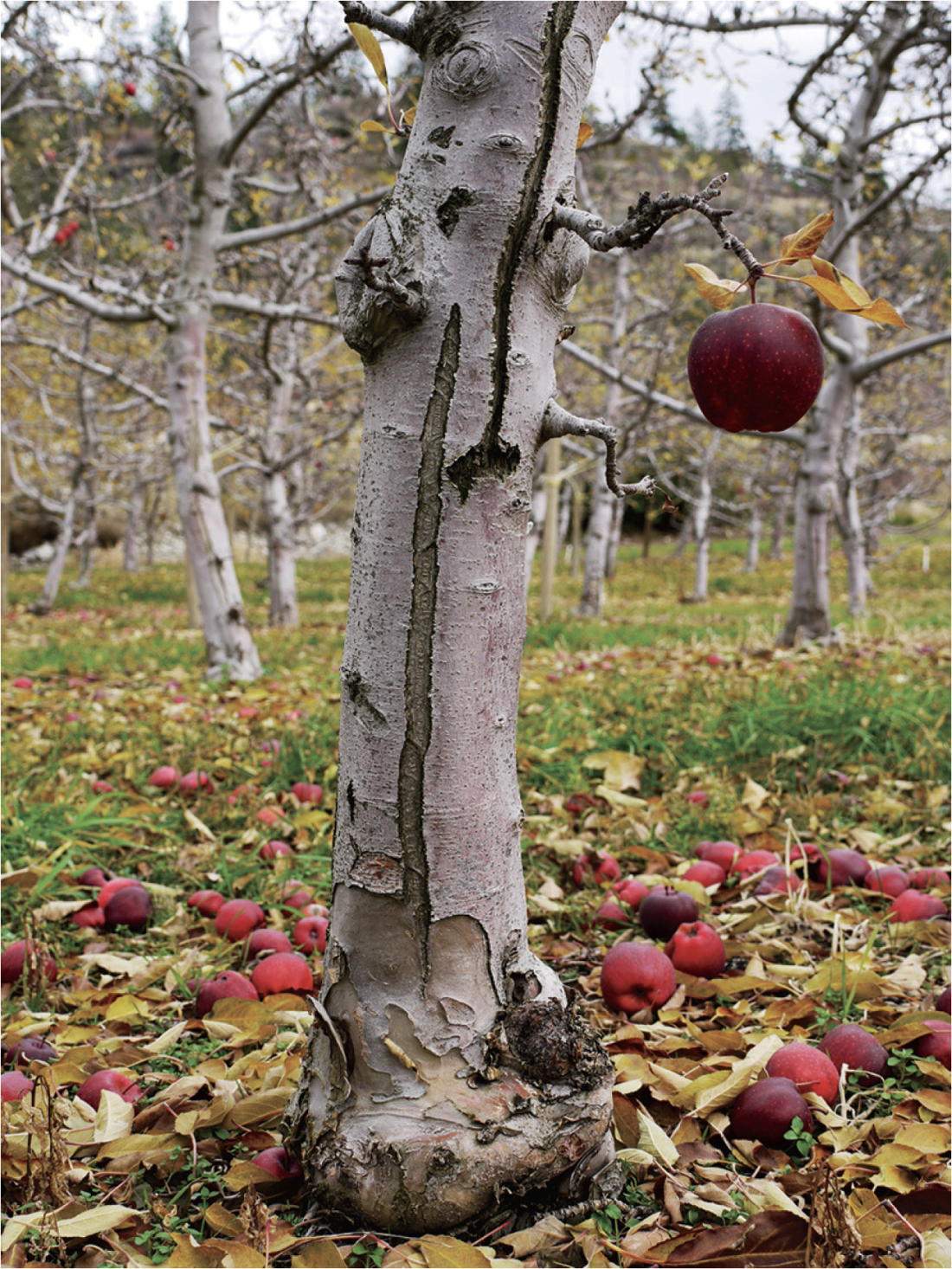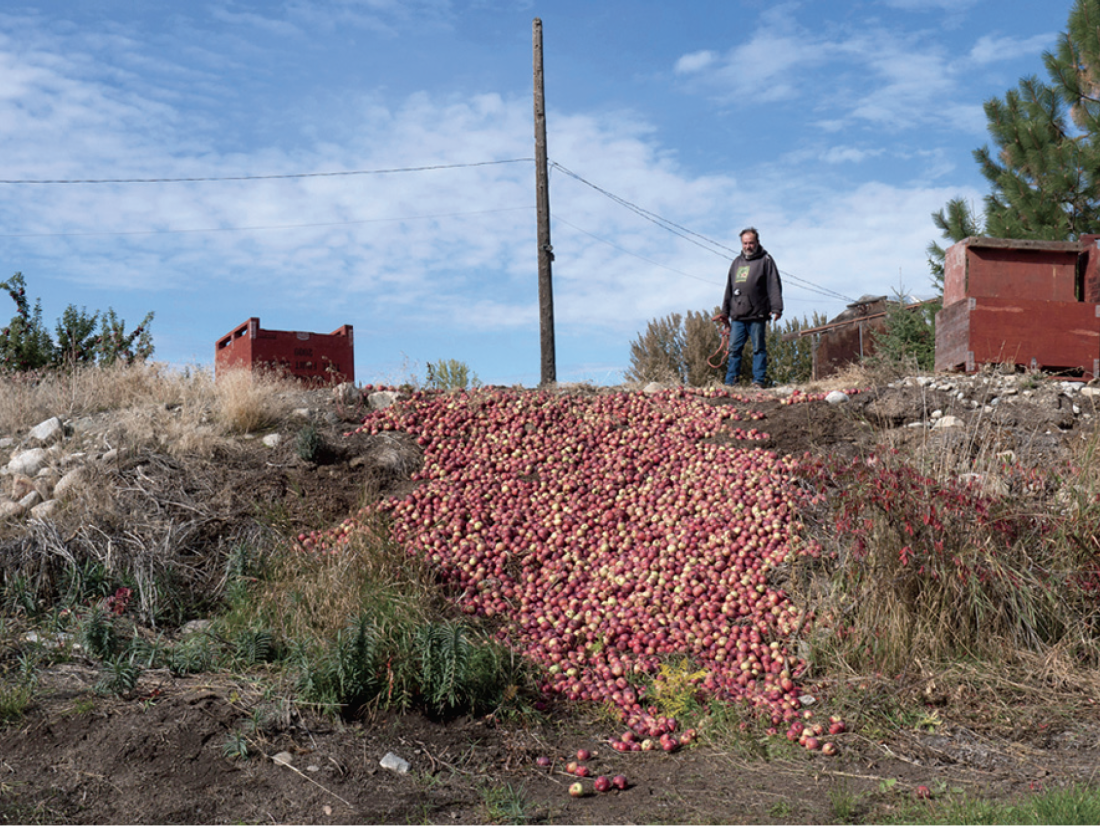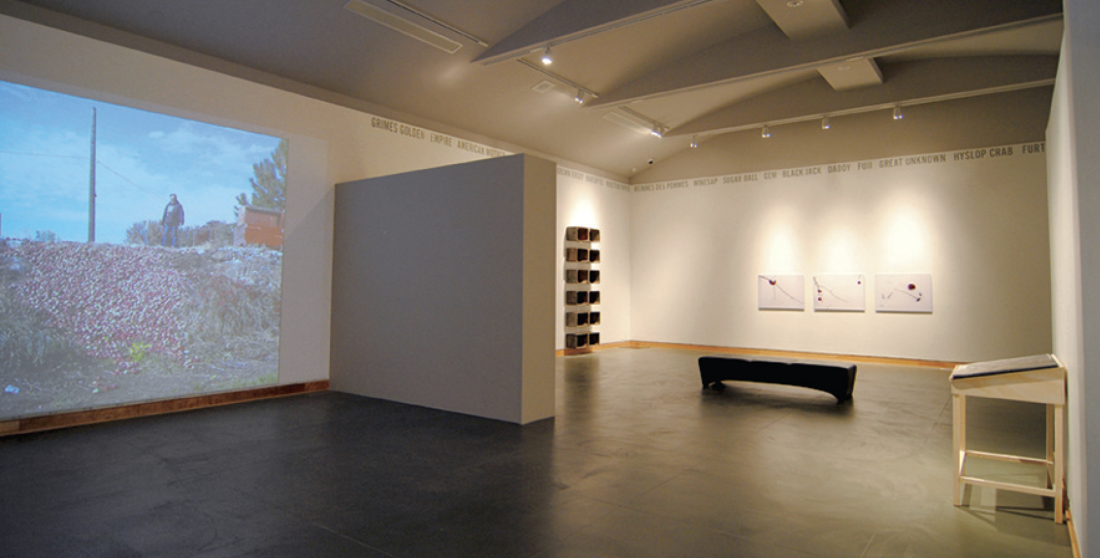Christos Dikeakos
This summer and fall, Vancouver artist Christos Dikeakos was the subject of a major exhibition titled “Nature Morte,” curated by Liz Wylie, at the Kelowna Art Gallery. The exhibition was accompanied by a handsome catalogue, which included essays by Liz Wylie, Claudia Beck, Harold Rhenisch and a foreword by Jeff Wall. “Nature Morte” was comprised of photographs, video, photo-data projection, text and book works, all of which concentrated on the “eternal” apple. The apple, well represented in the art and literature of the distant past, is not a common subject today. However, the artist and his wife actually own a property in Naramata, in British Columbia’s South Okanagan, that includes a small apple orchard. Their orchard was a location, although not exclusively, that contributed to much of the photographic representations in the exhibition. That the subject of the apple, so explicitly linked to the vernacular identity of the Okanagan, was interwoven with the dialectics of conceptual art, is what made this exhibition so fascinating.

Christos Dikeakos, Solo Red Delicious 2 November Left Side, 2011, inkjet photograph, 22 x 17 inches. All images courtesy Kelowna Art Gallery.
In her book titled The Lure of the Local: Senses of Place in a Multicentered Society, 1997, author Lucy Lippard wrote, “the dynamics of identity and cultural consciousness appear at the intersections of nature, culture, history and ideology [and] finding a fitting place for oneself in the world is finding a place for oneself in a story.” Lippard’s position on the idea of the local and cultural consciousness is in part connected to conceptual art in its heyday (mid-’60s to mid-’70s); references to late 20th and 21st century conceptual art practice might include On Kawara’s “Date Paintings,” Dan Graham’s “Homes for America,” Ed Ruscha’s book works or Robert Smithson’s magazine essays on site and non- site artworks. This era, and specifically as it is tied to the tradition of the document, the documentary, is crucial to the ethos of post-conceptual art and art photography in our time.
The quote by Lippard is strategic to this review and to contemplating the basis of Christos Dikeakos’s art practice. It is linked to the now legendary exhibition titled “955,000” that Lippard organized for the Vancouver Art Gallery in 1970. Dikeakos, included in the exhibition, was an art student at the time and a co-curator with fellow student Ilya Pagonis of “New Attitudes in Photography” at the UBC Student Union Gallery, which overlapped with “955,000” and featured many of the same artists. Thus, work by Dikeakos, Jeff Wall and Ian Wallace, for example, was shown alongside prominent Americans Carl Andre, Robert Smithson, Lawrence Weiner, Bruce Nauman and others. These exhibitions signalled that art on the West Coast was undergoing serious changes: Dikeakos, who at that time was also an assistant on Robert Smithson’s Glue Pour, a site-specific work produced for “955,000,” has said that both exhibitions “aimed at positioning photography as the new essential medium for artists.”

Christos Dikeakos, Apple Spill Dumped Culls, 2012, video projection.
The current exhibition, “Nature Morte,” was a cleverly orchestrated reprise of key configurations of conceptual-minimalist art practice, documentary photography, and a reinstatement of the critical importance of, to paraphrase Lippard, the local and a sense of place in a multi-centered society. Upon entering the exhibition, the first image encountered was a salon-scale photo-data projection titled Apple Spill Dumped Culls, 2012, which functioned as an in-your-face introduction to the dualism of the local and the international—that is to say, regionally specific non-art content and late 20th and 21st century avant-garde art. Substitute apples for glue and the composition of this work, although likely pure coincidence, bears a remarkable resemblance to Smithson’s Glue Pour, and I can only imagine the thoughts that went through Dikeakos’s mind when he encountered this scene at the back of a typical Naramata orchard. That said, the message was well received, although the lighting in the gallery did diminish the visual impact this dramatic photographic projection was capable of achieving. Two small print versions of this picture and other photographs by the artist, as well as collage works, photocopied images and text, vintage apple box labels, notations and sketches, and numerous text quotations of poetic and philosophical reflections and observations on the apple could be found in two large book-work/binders set on convenient reading stands. The binders were a delight to peruse, and accessible, with an eclectic assortment of absorbing content and entertaining ephemera. The binders functioned as a key to the multiple art and non-art narratives in this exhibition. For example, a copied image of a Rodchenko’s “Spatial Construction” was placed alongside a picture of a Donald Judd stacked, multipart box sculpture, and thumbnail sketches of apple boxes by Dikeakos—all of which served to contextualize the artist’s not so subtle Judd-like readymade sculpture of stacked wall-mounted apple boxes. The art references didn’t stop there: Apple Falls Corner Piece I & II, 2013, recalled Carl Andre’s floor pieces from the ’60s and ’70’s, and a text frieze listing names of apple varieties along the top of the gallery walls hinted at a Lawrence Weiner wall work. Were the reading stand binders a nod to Marcel Broodthaers?

Christos Dikeakos, installation view, “Nature Morte,” 2014, Kelowna Art Gallery. Photograph: Kyle L Porier.
All conceptual art references aside, the apple was the leitmotif of “Nature Morte,” and it was most directly and widely represented in the artist’s many documentary photographic works. Apples, shot outdoors from different angles and depth of field, in different seasons, of different varieties and under different sets of cultural and natural circumstances, yielded a wealth of visual information and evidenced flexibility in aesthetic judgment. On the latter point I sensed that Dikeakos, who certainly doesn’t lack critical rigor, allowed himself complete creative licence to photograph the apple under as many conditions of location and shot framing as he felt the subject/scene warranted. Indeed, the sheer variety of compositions resulted in the whole presentation being greater than the sum of its parts. These captivating photographs, in concert with other exhibition components, invited the audience to become immersed in the nature, culture, history, ideology and aesthetics of all things eternal—art, and the apple. ❚
“Nature Morte” was exhibited at the Kelowna Art Gallery from June 21 to October 5, 2014.
Gary Pearson is an artist and Associate Professor in the Department of Creative Studies at UBC Okanagan.

